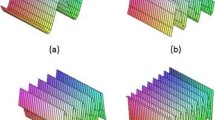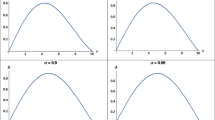Abstract
In this paper, we formulate a class of fractional order partial differential equations by concentrating on fractional order partial derivatives. We consider an initiative towards the formulation of fractional order Schrödinger equations, heat equation, and wave equation in the realm of fractional calculus. For a given fractional number, we obtain their respective fractional order solutions. In the light of fractional order quantum mechanics, we extend our analysis further for various potential functions for the case of the time-independent and time-dependent Schrödinger equations. Hereby, our proposal gives a refined solution to discrete dynamical systems. Namely, instead of taking the integral-valued steps in the evolution of a chosen dynamical system, it takes fractional-valued steps while performing an integral or solving a system of differential equations. Finally, concerning the extended analysis of our fractional order solutions, we anticipate interesting applications of the above formulation in other domains of physical sciences and natural systems.
Similar content being viewed by others
References
Abdon, A., Dumitru, B.: New fractional derivatives with nonlocal and non-singular kernel: theory and application to heat transfer model. Thermal Sci. 20(2), 763–769 (2016)
Baleanu, D., Jajarmi, A., Bonyah, E., Hajipour, M.: New aspects of the poor nutrition in the life cycle within the fractional calculus. Adv. Differ. Equ. 2018(1), 230 (2018)
Baleanu, D., Asad, J.H., Jajarmi, A.: New aspects of the motion of a particle in a circular cavity. Proc. Roman. Acad. Ser. A 19(2), 361–367 (2018)
Birkhoff, G., Von Neumann, J.: The Logic of Quantum Mechanics, The Logico-Algebraic Approach to Quantum Mechanics. The University of Western Ontario Series in Philosophy of Science Volume 5a, pp. 1–26 (1975) (Online ISBN: 978-94-010-1795-4)
Black, F., Scholes, M.: The pricing of options and corporate liabilities. J. Polit. Econ. 81(3), 637–654 (1973)
Debnath, L.: Nonlinear Partial Differential Equations for Scientists and Engineers, 3rd edn. Birkhäuser, Basel (2012)
Dirac, P.A.M.: The Principles of Quantum Mechanics” (International Series of Monographs on Physics), 4th edn. Oxford University Press, Oxford (1982). (ISBN-13: 978-0198520115)
Espanol, P., Warren, P.: Statistical mechanics of dissipative particle dynamics. Europhys. Lett. 30(4), 191 (1995)
Hajipour, M., Jajarmi, A., Baleanu, D., Sun, H.: On an accurate discretization of a variable-order fractional reaction diffusion equation. Commun. Nonlinear Sci. Numer. Simul. 69, 119–133 (2019)
Hilfer, R. (ed.): Applications of Fractional Calculus in Physics. World Scientific Publishing Co. Pie. Ltd., Singapore (2000). (ISBN: 9810234570)
Huang, K.: Statistical Mechanics, 2nd edn. Wiley, New York (1987). (ISBN-13: 978-0471815181)
Jajarmi, A., Baleanu, D.: A new fractional analysis on the interaction of HIV with CD4+ T-cells. Chaos, Solitons Fractals 113, 221–229 (2018)
Jajarmi, A., Baleanu, D.: Suboptimal control of fractional-order dynamic systems with delay argument. J. Vib. Control 24(12), 2430–2446 (2018)
Kong, X., Ravndal, F.: Proton-proton fusion in leading order of effective field theory. Nucl. Phys. A 656(3–4), 421–429 (1999)
Machado, J.A.T., Galhano, A.M.S.F., Trujillo, J.J.: On development of fractional calculus during the last fifty years. Springer, Netherlands, Scientometrics 98(1), 577–582 (2014)
Miller, K.S.: An Introduction to the Fractional Calculus and Fractional Differential Equations, 1st edn. Wiley-Interscience, New York (1993). (ISBN-13: 978-0471588849)
Oldham, K.B., Spanier, J.: The Fractional Calculus: Theory and Applications of Differentiation and Integration to Arbitrary Order, Dover Books on Mathematics. Dover Publications, New York (2006). (ISBN-13: 978-0486450018)
Podlubny, I.: Fractional Differential Equations. Mathematics in Science and Engineering, Book No. 198, 1st edn. Academic Press, New York (1998)
Potter, M.C., Goldberg, J.L., Aboufadel, E.: Advanced Engineering Mathematics, 3rd edn. Oxford University Press, Oxford (2005). (ISBN-13: 978-0195160185)
Rivero, M., Trujillo, J.J., Velasco, M.P.: On Deterministic Fractional Models. In: Dumitru, B., Ziya, B.G., Tenreiro, J.A. (eds.) Machado in the book New Trends in Nanotechnology and Fractional Calculus Applications, pp. 123–150. Springer, Netherlands (2010). (Online ISBN: 978-90-481-3293-5)
Sakurai, J.J.: Modern Quantum Mechanics. Addison Wesley, New York (1993). (ISBN-13: 978-0201539295)
Tiwari, B.N.: On Generalized Uncertainty Principle. LAP LAMBERT Academic Publishing, New York (2011). (ISBN-13: 978-3846515327)
Web, M.: Analysis and Approximation of a Fractional Differential Equation. Part C Mathematics Dissertation, Oxford University, Hilary Term (2012)
Williams, P.: Fractional Calculus of Schwartz Distributions. Department of Mathematics and Statistics, The University of Melbourn (2007)
Young, R.D.: Theoretical total-energy distribution of field-emitted electrons. Phys. Rev. 113(1), 110 (1959)
Acknowledgements
B.N.T. wishes to express his sincere thanks to Professor Jagdish Rai Luthra and Professor Padmakali Banerjee for their valuable support and encouragements towards the realization of this research. B.N.T. also acknowledges the hospitality provided at the INFN-Laboratori Nazionali di Frascati, Roma, Italy while this work was in progress in 2014. B.N.T. would like to thank the Yukawa Institute of Theoretical Physics at Kyoto University. Discussions during the workshop YITP-T-18-04 “New Frontiers in String Theory 2018” were useful to complete this work. The authors would like to express their sincere thanks to unknown referees for their valuable comments and suggestions towards the improvement of this Manuscript.
Author information
Authors and Affiliations
Corresponding author
Additional information
Publisher's Note
Springer Nature remains neutral with regard to jurisdictional claims in published maps and institutional affiliations.
Appendix: physical motivations
Appendix: physical motivations
In this Appendix, we offer a brief review of the physical motivations in the realm of ordinary calculus whose generalizations we have sought in the light of fractional differentiation. These are the three well-known equations, namely, the Schrödinger, heat, and wave equations that play a major role in understanding the laws of physics.
1.1 Schrödinger equation
First of all, the Schrödinger equation is based on De Broglie’s hypothesis, laws of the conservation of energy and momentum, and the classical plane wave equation. For instance, the Schrödinger equation explicates phenomena of the barrier penetration, whereby the emission of alpha particles [25] and proton fusion process, see [14] in the light of leading order effective theories.
Physically, pertaining to the atomic description of the world, it is known that the Schrödinger equation, when applied to hydrogen atom [21] yields a wave function that depends upon a triple of the quantum numbers, viz. the principal, azimuthal and magnetic quantum numbers. When the given potential energy \( V \) is independent of the time, the time-independent Schrödinger equation [7] takes the following form
where \( \psi \) is termed as the wave function. More precisely, \( \psi \) is an element of the Hilbert space, for instance, see [4] towards the logical understanding of quantum mechanics.
1.2 Wave equation
Traditionally, in 1746, De Alembert introduced the one-dimensional wave equation, whereby within 10 years of the duration, Euler extended it to the case of the three-dimensional wave equations [19]. Indeed, there are various generalizations and associated developments.
Mathematically, the wave equations can be realized as a hyperbolic partial differential equation [6] that typically concerns a time variable \( t \), and one or more spatial variables \( {\text{x}}_{1} ,{\text{x}}_{2} , \ldots , {\text{x}}_{\text{n}} \) for a scalar function \( u = u\left( {x_{1} ,x_{2} , \ldots ,x_{n} ,t} \right) \) whose values model the displacement of a wave in \( n - \) dimensional background Euclidean space \( {\mathbb{R}}^{n} \), see [19] for an introduction of typical partial differential equations in applied mathematics and engineering mathematics.
For a given scalar function \( u:{\mathbb{R}}^{n + 1} \to {\mathbb{R}} \) as mentioned in the introduction section, the wave equation can be expressed as per the following expression
where \( a \) is a fixed constant that defines the propagation speed of the wave and \( \nabla^{2} \) denotes the standard Laplacian operator that reads as per the representation
1.3 Heat equation
In reference to the above Schrödinger and wave equations, the heat equation governs the temperature distribution of an object in a given domain of the space–time. This partial differential equation that describes the flow of the heat energy, wherefore the behavior of the temperature is worth examining in an enlarged setting of the fractional calculus. In particular, the heat equation in (1 + 1) dimensional space-times is given [19] as
where \( {\text{K}} \) is a positive constant defining the thermal diffusivity. In this case, we can think of a one-dimensional rectangular thin wire of its length \( {\text{x}} \) at a given temperature profile. Ignoring the wire’s width and height dimensionalities, we may perform the analysis of temperature flows as follows. Let one of the ends along the length of the wire is set at 0 °C, whereas the other end is set to vary about 0 °C. The heat equation can be derived from the Fourier law and conservation of the energy, see [19] for associated details. Herewith, the heat equation is of the fundamental importance in varied fields of scientific research and developments.
Rights and permissions
About this article
Cite this article
Tiwari, B.N., Thakran, D.S., Sejwal, P. et al. Fractional order solutions to fractional order partial differential equations. SeMA 77, 27–46 (2020). https://doi.org/10.1007/s40324-019-00200-2
Received:
Accepted:
Published:
Issue Date:
DOI: https://doi.org/10.1007/s40324-019-00200-2
Keywords
- Fractional calculus
- Fractional solutions
- Fractional Schrödinger equations
- Fractional heat equation
- Fractional wave equation




